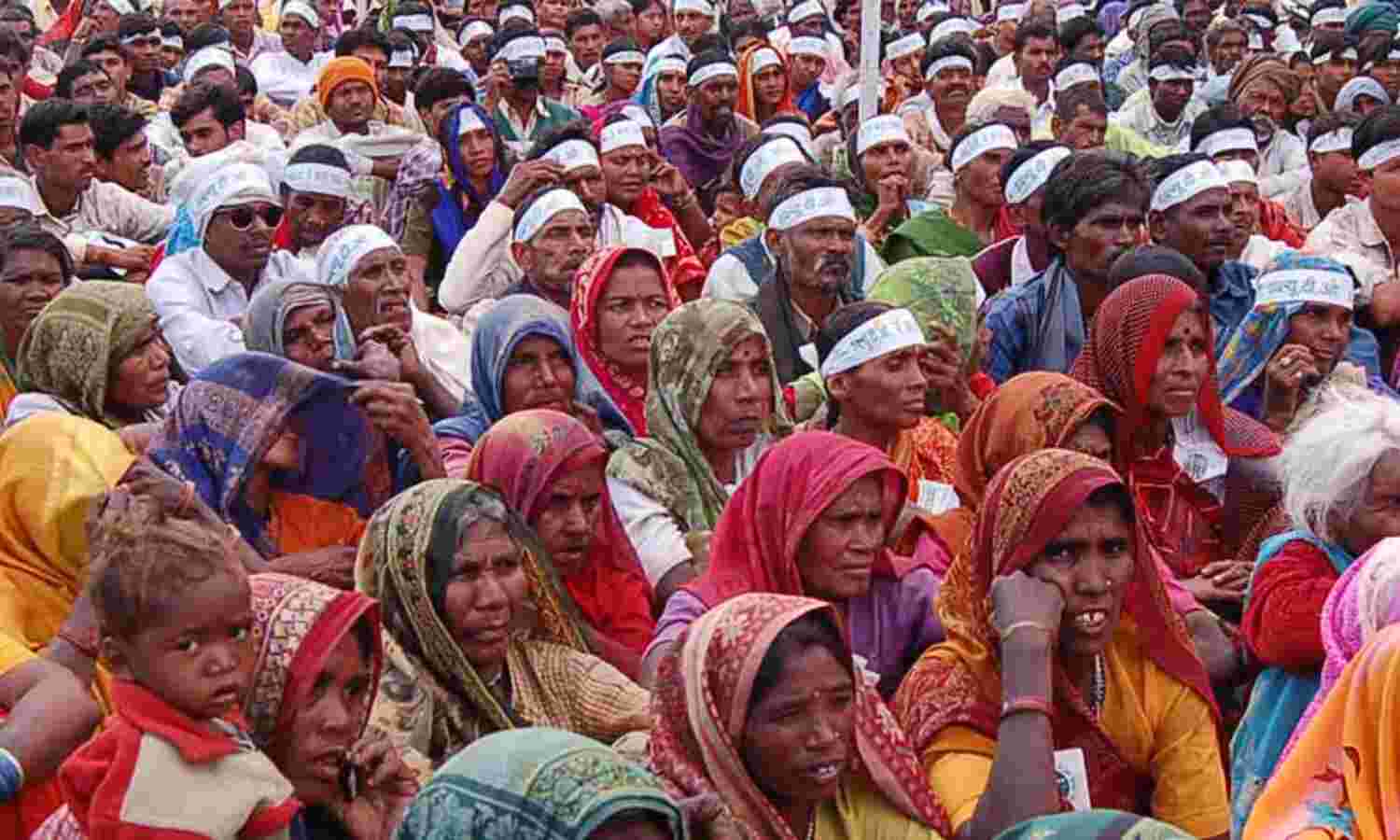Farm Distress Influenced Elections In MP, Rajasthan And Chhattisgarh, But Not In Telangana

Mumbai: Widespread farm distress--which brought more than 100,000 farmers to New Delhi in November 2018--appears to have affected the elections to the legislative assemblies of Rajasthan, Madhya Pradesh and Chhattisgarh.
As of 5.30 pm on December 11, 2018, the Indian National Congress (Congress) is set to form state governments in all three states, defeating the incumbent Bharatiya Janata Party (BJP).
Congress president Rahul Gandhi and many opposition leaders from across the country lent support to the Kisan Mukti March on November 30, 2018, which demanded that parliament hold a special 21-day session to address the agrarian crisis.
Between 2004 and 2016, Madhya Pradesh recorded 16,932 farmer suicides--more than three every day, and the fourth highest number nationwide--according to this FactChecker.in analysis dated October 22, 2018. Chhattisgarh followed with 12,979 suicides--nearly three everyday, and the fifth highest nationwide. Rajasthan ranked the 11th highest with 5,582 suicides during the same period.
India grew more foodgrain in 2017 than ever before, and the government’s agriculture budget rose 111% over four years to 2017-18, as IndiaSpend reported in January 2018. Yet prices crashed, unpaid agricultural loans grew 20% over the year to 2017, and 600 million Indians who depend on farming struggled to get by.
However, farm distress did not prevent the Telangana Rashtra Samithi (TRS) from sweeping the polls and returning to power in the youngest Indian state, 55.5% of whose population earns a living from farming. Tenancy is on the rise in Telangana as small farmers seek to cultivate more land to make farming viable, IndiaSpend reported on December 6, 2018. Without titles, however, they cannot access bank loans and benefit schemes, and are pushed into the hands of usurious moneylenders, our ground investigation found.
We curated a list from the IndiaSpend archives on the stress roiling rural India:
Widespread #farmdistress appears to have affected the elections to #Rajasthan, #MadhyaPradesh and #Chhattisgarh assemblies. As of 4.30 pm today, the Congress is set to form governments in all 3 states, defeating the incumbent BJP. Follow this thread to understand #farmdistress
— IndiaSpend (@IndiaSpend) 11 December 2018
Why are #farmers unhappy in #MadhyaPradesh with 10.9% avg agri growth per annum over 8 years, the highest in India (national avg: 4.3%)? Our analysis shows farm incomes have not grown: https://t.co/DnFRnQDwdE #Results2018
— IndiaSpend (@IndiaSpend) 11 December 2018
MP’s farmers grow 12% of India’s foodgrain, 31% of pulses, 19% of wheat. The state’s farm economy grew 10.9% in 8 yrs, the fastest nationwide. Yet, #farmers are frustrated, angry & tired. Here’s why: https://t.co/qYPpX1H5D9 #Results2018
— IndiaSpend (@IndiaSpend) 11 December 2018
#Notebandi decimated vegetable & flower prices in Indore, MP’s commercial capital. We spent a day with Keshu Singh Patel, a farmer whose income fell 70% in the season from Oct’16-Jan-17 because of low chrysanthemum prices: https://t.co/u8n1Ft0xm8 #Results2018 #farmdistress
— IndiaSpend (@IndiaSpend) 11 December 2018
In #Chhattisgarh, India’s rice bowl, 4.3m farmers in all 27 districts are unhappy with agriculture-related promises remaining unfulfilled since 2013, including Rs 300 per quintal bonus for paddy: https://t.co/GDGtgZaupg #Results2018
— IndiaSpend (@IndiaSpend) 11 December 2018
In #Chhattisgarh, industry & mining generate 48% of GDP but employ 5% workforce. #Agriculture generates 17% of GDP but employs 80%. Govt delays land, forest rights in mineral-rich but impoverished tribal areas, leaving state in ferment: https://t.co/iyrjZ0r8kh #Results2018
— IndiaSpend (@IndiaSpend) 11 December 2018
Only 34% #farmer widows in M'tra get pension, 40% don’t have their own ration card. A new study shows how lack of safety net for women whose husbands have committed suicide renders them unable to cope with debt, droughts & poor harvests: https://t.co/0PxXfFJQjZ #Results2018
— IndiaSpend (@IndiaSpend) 11 December 2018
In 2030, India’s agri output might be 7 points lower--at 1.56 times the 2010 level against a potential 1.63 times without climate change--and the number of hungry 22.5% higher at 90.5 mn against 73.9 mn without #climatechange: https://t.co/louIXRWADr #Results2018 #farmdistress
— IndiaSpend (@IndiaSpend) 11 December 2018
India had record farm harvest in 2017 & govt’s agri budget rose 111% over 4 yrs to 2017-18 yet prices crashed, unpaid agri loans grew 20% (2016-17) and 600mn Indians who depend on farming struggle to get by: https://t.co/KvUVaoeO0M #Results2018 #farmdistress
— IndiaSpend (@IndiaSpend) 11 December 2018
In #Maharashtra, the increasing squeeze on the cattle business threatens to cripple the thriving livestock markets that are intrinsic to rural agrarian culture, we found: https://t.co/FOmqx4AhY3 #Results2018 #farmdistress
— IndiaSpend (@IndiaSpend) 11 December 2018
Nearly 70% of India’s 90 million agricultural households spend more than they earn on average each month, pushing them towards debt, the primary reason for more than half the farmer suicides recorded nationwide: https://t.co/pEVymciQNs #Results2018 #farmdistress
— IndiaSpend (@IndiaSpend) 11 December 2018
Imports after plentiful harvest in 2016 drove down prices; notebandi caused cash shortage; >50% farms depend on rains after >Rs 3.5 lakh crore invested over 60+ yrs in irrigation. Why 90 million families agitated in 2017: https://t.co/iFb2rGNvst #Results2018 #farmdistress
— IndiaSpend (@IndiaSpend) 11 December 2018
Several states gave in to loan waiver demands, primarily to discourage #farmer suicides, apparently caused by widespread indebtedness. Our analysis found this would have little or no impact in easing the agrarian crisis: https://t.co/75kED4IPzT #Results2018 #farmdistress
— IndiaSpend (@IndiaSpend) 11 December 2018
Five months after #Maharashtra’s BJP government announced it would waive loans of Rs 34,022 crore for 8.9 million #farmers in June 2017, we looked at how the state bungled this: https://t.co/0gNN3sEVnM #Results2018 #farmdistress
— IndiaSpend (@IndiaSpend) 11 December 2018
One year after govt demonetised Rs 500 & Rs 1,000 notes, in November 2017 we found farmers in Nashik, India’s onion bowl, unable to go cashless, struggling to buy seeds & equipment & to pay labourers, & dependent on moneylenders: https://t.co/mQPwT3yTbc #Results2018 #farmdistress
— IndiaSpend (@IndiaSpend) 11 December 2018
We welcome feedback. Please write to respond@indiaspend.org. We reserve the right to edit responses for language and grammar.


